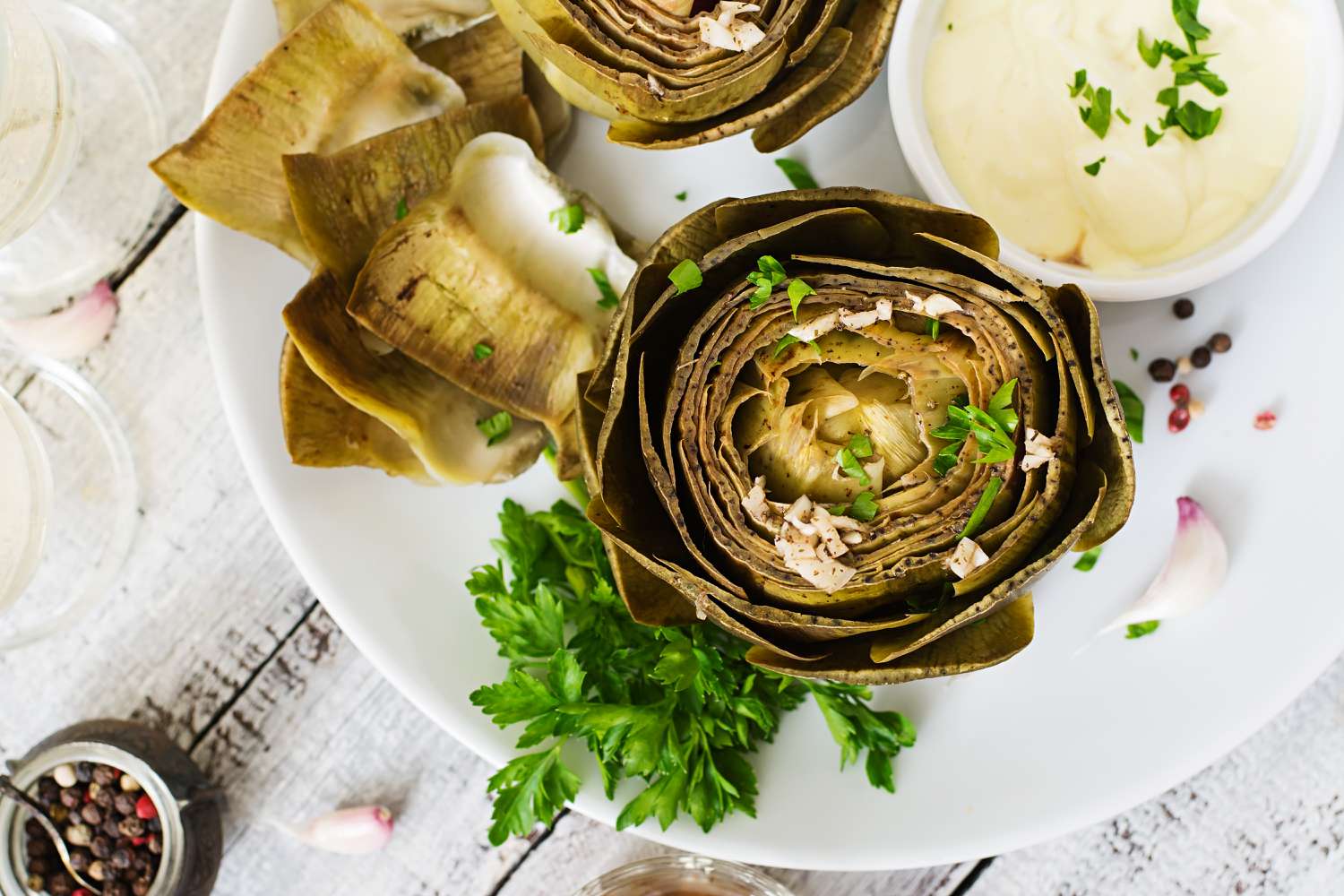
How to Eat an Artichoke the Right Way, According to a Legendary Chef
Artichokes are an irresistibly photogenic vegetable, resembling a giant green acorn encased in a scaly armor of green bracts. Therein lies the challenge: How do you breach that spiked barrier to reach the best part of an artichoke—its guarded, hidden heart? If you have hesitated because you are not sure how to eat an artichoke, know that fresh artichokes are in a flavor class of their own, and delicious adventure awaits. Ahead, we spoke to three experts—a grower, a legendary chef, and an artichoke ambassador—who share their artichoke wisdom with us.
What Is an Artichoke?
Globe artichokes are the flower buds of a giant thistle, Cynara cardunculus var. scolemus, a member of the daisy family native to the Mediterranean. Unharvested artichokes develop into showy, bright purple-tufted flowers. Sold as a vegetable, artichokes are usually green, but there are also purple varieties.
Which Parts of an Artichoke Are Edible?
An artichoke’s edible parts include its stem’s peeled core, the base of each bract (commonly called the artichoke’s leaves), and the heart. The choke in an artichoke is found at its heart: these bristles are the earliest stage of the developing flower petals. In mature artichokes, the choke can be very spiky and should be scooped out. But in younger or baby artichokes, the hairs can be so silky and fine that they dissolve in the mouth. Evan Chender, a chef turned sought-after culinary grower in Asheville, North Carolina, points out that particular artichoke cultivars like ‘Violetto’ are smaller and have very little or no choke in the center. They are used whole because “after minimal cleaning, they can be eaten in their entirety.”
The Taste and Texture of an Artichoke
A cooked artichoke tastes something like a potato meeting a chestnut, by way of an asparagus, with a hint of subtle, creamy earthiness. Or like a cooked lotus root! Traditional artichoke accompaniments include lemon and melted butter or Hollandaise sauce, if they are served warm; and mayonnaise or a vinaigrette if served cold.
How to Choose an Artichoke
Judy Burditt, who is the manager of the California Artichoke Advisory Board (California’s state vegetable is the artichoke), shares three things to look for:
- Don’t always look for the biggest, prettiest artichoke: Look for smaller to medium-sized artichokes.
- Check to see that the bracts are tight and not spread.
- Pick it up: When it’s in your hand, it should feel weighty. If it’s light, it has probably been sitting out too long. Give it a squeeze: If it squeaks, it means it’s fresh.
To revive a wilted artichoke: Cut a slice from the stem, then place stem-side-down in a bowl of cold water for about an hour before cooking or storing them: “A hydrated artichoke will cook a lot faster than a dehydrated one, and provides a much more enjoyable eating experience,” says Burditt.
How to Eat an Artichoke
For Jacques Pépin, legendary chef and culinary educator Jacques Pépin, who has been eating artichokes for 80 years, the simplest method can be the best: “A beautiful artichoke, you cook whole,” he says. They may then be eaten hot or cold, leaf by leaf, because artichokes are finger food. Pull off the bracts, one by one, then use your teeth to scrape off the tender flesh from each base. Work your way steadily through each bract, getting a slightly bigger reward every time. Once you reach the center and the potentially hairy choke, use a spoon to scrape it out. Discard the hairs, and carry on to the treasure—the heart. You have arrived. Eat it in a few bites, dipping the pieces into warm butter or cold mayonnaise.
To be able to eat an artichoke like Pépin, you first need to cook it:
Boil or Steam Whole
This is the easiest way to cook a fresh artichoke. Depending on their size, boiling or steaming artichokes may take between 10 and 30 minutes. They are ready when their base, pierced deeply with a sharp knife, is tender. Pépin chooses this method at home, and, before cooking, uses scissors to trim from the bracts “the little needles on the top that are not nice to eat.” After boiling in salted water, he says, “I remove the center leaves from the top … reveal the choke, remove it, and place those leaves that I removed back on top upside down for presentation. That would be served with a good vinaigrette or mayonnaise.”
Another wonderful accompaniment is Hollandaise sauce: Pépin tells the story of when his daughter Claudine was young and at a friend’s house where artichokes were served. “She wasn’t eating,” he says, “and the mother asked, ‘What is wrong, Claudine? Do you not like artichokes?’ She said, ‘Oh, no I do, but I’m waiting for the Hollandaise sauce!'”
Grilling
Once boiled or steamed, an alternative method is to finish them by grilling, which brings out a sweeter flavor. Halve each artichoke and grill them. If the exposed chokes are spiky, scoop them out with a spoon. Brush with oil or butter, then lay the artichokes face-down on your grill, or face-up under a broiler and cook for a few minutes until you have some brown edges. Serve warm with lemon.
Hearts Only: Stewing, Stuffing, and Baking
Artichokes can also be stripped of all their leafy bracts and the large hearts stewed slowly with herbs and oil, in a method known as barigoule, typical of the South of France. Or the hearts can be stuffed—after the choke has been removed—and baked. These are the most labor-intensive way to prepare them and also a good way to use artichokes that are beyond their prime.
What Influences an Artichoke’s Flavor?
Cold Weather: Burditt says that a couple of factors can affect their flavor. Those harvested after frost, for example, taste better because cold effectively “cooks” artichokes and improves the softness and flavor of their edible tissue. And when artichokes mature slowly, in cool spring climates, “they get very thick and meaty. If you add an early frost, even that much better,” she says.
Type of Artichoke: Chender says that while modern varieties are bred to be harvested quickly, slow-growing, heritage types that mature through winter before making buds, “have better flavor and texture.”
Artichokes and Wine
Artichokes are infamously difficult to pair with wine because they contain cynarin, a substance that inhibits your tongue’s perception of sugar. “Usually, you’re not supposed to drink wine with artichokes, but that doesn’t prevent me from enjoying a glass of white,” says Pépin. A sip of water to wash off the cynarin before your sip of Sauvignon Blanc helps.










